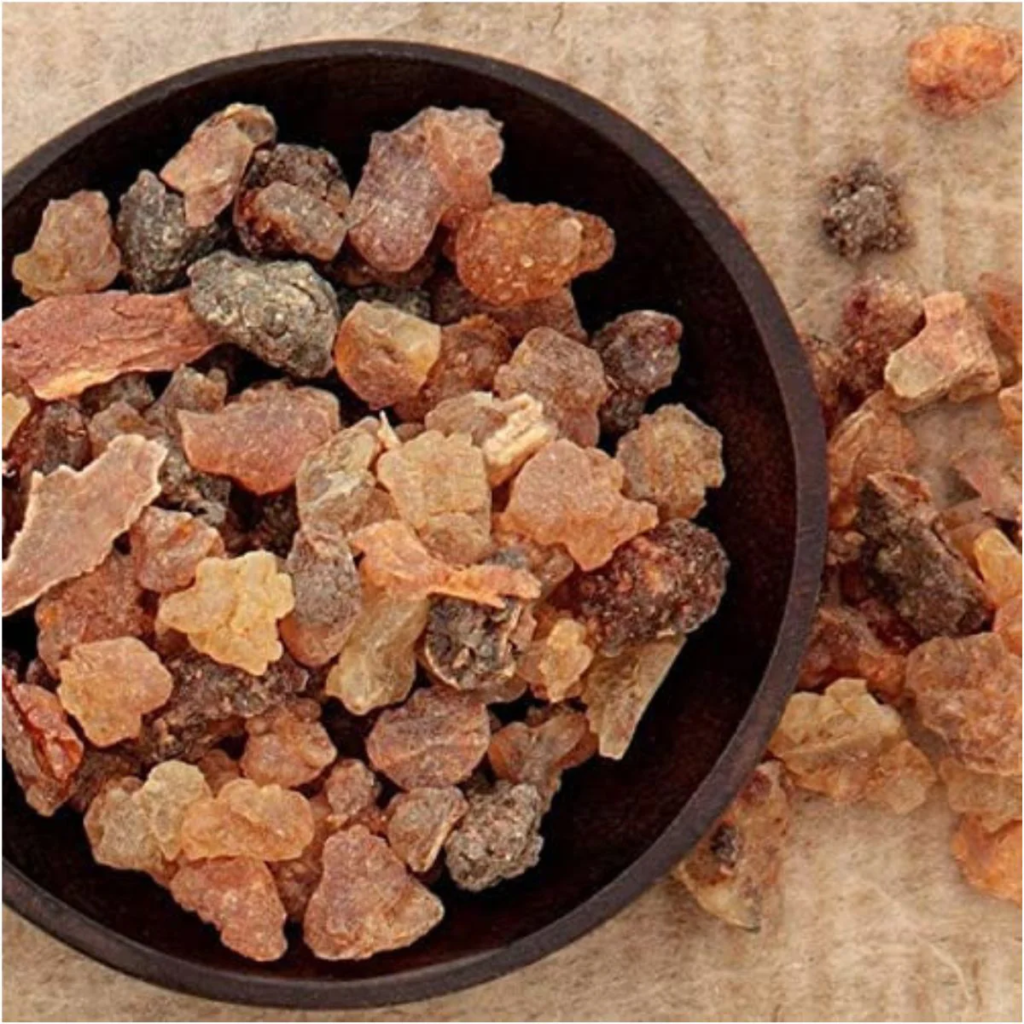1. Introduction to Myrrh
Myrrh is a natural resin obtained from trees of the genus Commiphora, mainly Commiphora myrrha and Commiphora gileadensis. It has been used since ancient times in traditional medicine, religious rituals, and perfumery. Myrrh is particularly famous for its aromatic properties and medicinal benefits, being an integral part of the pharmacopeias of Ayurveda, Traditional Chinese Medicine (TCM), and Unani medicine. The word “myrrh” originates from the Arabic word “murr,” meaning “bitter,” which describes its characteristic taste.

The resin of myrrh trees is exuded in response to natural or artificial incisions in the bark. It hardens into reddish-brown globules and is then harvested. Myrrh’s historical significance extends to ancient Egypt, where it was used in embalming, as well as in the religious offerings of various cultures.
In modern times, scientific studies have validated many of myrrh’s traditional uses, highlighting its antimicrobial, anti-inflammatory, and analgesic properties. It is extensively used in the pharmaceutical, cosmetic, and food industries.
2. Composition of Myrrh
Myrrh is a complex mixture of bioactive compounds, including resins, essential oils, gums, and bitter principles. The key components are:
Resins (25-40%): The resin fraction primarily consists of sesquiterpenoids and triterpenoids, which contribute to myrrh’s medicinal properties. These compounds possess anti-inflammatory, antimicrobial, and anticancer effects.
Essential Oils (3-8%): Myrrh contains volatile oils rich in terpenoids, responsible for its characteristic aroma and biological activities.
Gums (30-60%): The gum fraction consists of polysaccharides such as arabinose, galactose, and glucuronic acid, which have immunomodulatory properties.
Bitter Principles: These compounds contribute to myrrh’s digestive benefits and its traditional use in promoting appetite and digestive health.
3. Chemistry of Myrrh
The active compounds in myrrh have been extensively studied. The most significant chemical constituents include:
3.1 Sesquiterpenoids
- Furanoeudesma-1,3-diene
- Curzerene
- Furanodienone
- Lindestrene
3.2 Triterpenoids
- α- and β-boswellic acids
- Tirucallol
- Acetyl-11-keto-β-boswellic acid (AKBA)
3.3 Volatile Oils
- Limonene
- α-pinene
- Elemol
- Myrcene
3.4 Phenolic Compounds
- Eugenol
- Vanillin derivatives
These compounds exhibit pharmacological activities such as antimicrobial, anti-inflammatory, antioxidant, and anticancer properties.
4. Bio-Sources of Myrrh
Myrrh is primarily sourced from trees in the Burseraceae family, native to arid and semi-arid regions. The major producers include:
Geographical Distribution
- Africa: Somalia, Ethiopia, Eritrea, Kenya, Sudan.
- Arabian Peninsula: Yemen, Oman, Saudi Arabia.
- India: Found in limited quantities in Rajasthan and Gujarat.
Collection and Processing
Myrrh is harvested by making incisions in the bark of Commiphora trees, causing the resin to exude. The hardened resinous droplets are collected manually and then purified for commercial use.
5. Therapeutic Uses of Myrrh
Myrrh has a long history of use in traditional medicine for treating various ailments. Its key pharmacological benefits include:
Anti-Inflammatory Properties: Myrrh reduces inflammation by inhibiting pro-inflammatory cytokines and enzymes such as cyclooxygenase (COX-2) and lipoxygenase. Effective in treating arthritis, inflammatory bowel disease, and skin conditions like psoriasis.
Antimicrobial and Antifungal Effects: Myrrh exhibits potent antibacterial activity against Staphylococcus aureus, Escherichia coli, and Pseudomonas aeruginosa. Its antifungal properties are useful in treating Candida albicans infections.
Analgesic Effects: Used in traditional medicine to alleviate toothaches, sore throats, and menstrual cramps. Works by modulating opioid receptors and reducing pain perception.
Gastrointestinal Health: Myrrh is used to treat indigestion, ulcers, and diarrhea. It enhances gut motility and has antimicrobial effects against Helicobacter pylori.
Respiratory Benefits: Used in treating bronchitis, asthma, and colds due to its expectorant and antimicrobial properties.
Wound Healing: Myrrh accelerates wound healing by promoting collagen synthesis and preventing infections.
Anticancer Potential: Studies suggest that myrrh extracts induce apoptosis in cancer cells, particularly in breast and liver cancers.
6. Commercial Applications of Myrrh
Due to its diverse medicinal and aromatic properties, myrrh is widely utilized in various industries.
Pharmaceutical Industry: Incorporated into antiseptic solutions, mouthwashes, and herbal formulations. Used in traditional herbal remedies for digestive and respiratory conditions.
Cosmetic and Personal Care Industry: A key ingredient in perfumes, skin creams, and hair care products. Added to anti-aging formulations due to its antioxidant properties.
Food and Beverage Industry: Occasionally used as a flavoring agent in bitters and liqueurs.
Religious and Cultural Uses: Myrrh has been used in religious rituals, incense burning, and embalming since ancient times. Incorporated in traditional ceremonies in Middle Eastern and African cultures.
Aromatherapy and Alternative Medicine: Used in essential oils for relaxation, meditation, and stress relief. Combined with frankincense for synergistic therapeutic effects.
Conclusion
Myrrh remains a highly valued natural product due to its rich chemical composition, extensive pharmacological benefits, and broad commercial applications. Ongoing scientific research continues to explore its therapeutic potential, particularly in antimicrobial and anticancer therapies. Given its historical and modern relevance, myrrh continues to be an indispensable natural remedy in various fields, from medicine to perfumery.
Further research into its bioactive compounds and clinical applications may lead to the development of novel pharmaceutical formulations, solidifying myrrh’s place in modern medicine.

